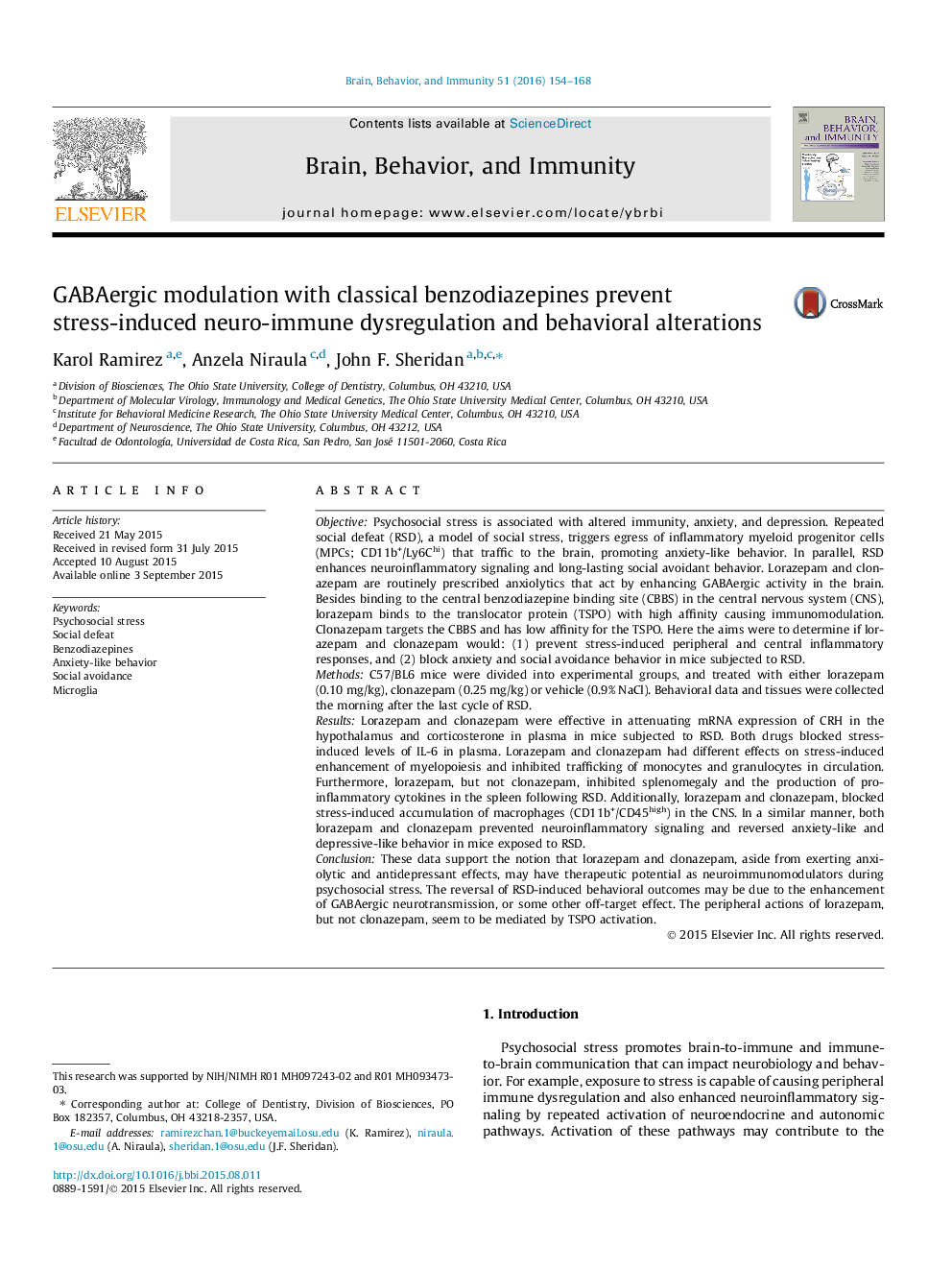| کد مقاله | کد نشریه | سال انتشار | مقاله انگلیسی | نسخه تمام متن |
|---|---|---|---|---|
| 922199 | 1473916 | 2016 | 15 صفحه PDF | دانلود رایگان |
• Classical benzodiazepines ameliorated stress-induced neuroimmune responses.
• Lorazepam and clonazepam blocked stress-induced neuroinflammatory signaling.
• Classical benzodiazepines reversed anxiety-like and depressive-like behavior.
ObjectivePsychosocial stress is associated with altered immunity, anxiety, and depression. Repeated social defeat (RSD), a model of social stress, triggers egress of inflammatory myeloid progenitor cells (MPCs; CD11b+/Ly6Chi) that traffic to the brain, promoting anxiety-like behavior. In parallel, RSD enhances neuroinflammatory signaling and long-lasting social avoidant behavior. Lorazepam and clonazepam are routinely prescribed anxiolytics that act by enhancing GABAergic activity in the brain. Besides binding to the central benzodiazepine binding site (CBBS) in the central nervous system (CNS), lorazepam binds to the translocator protein (TSPO) with high affinity causing immunomodulation. Clonazepam targets the CBBS and has low affinity for the TSPO. Here the aims were to determine if lorazepam and clonazepam would: (1) prevent stress-induced peripheral and central inflammatory responses, and (2) block anxiety and social avoidance behavior in mice subjected to RSD.MethodsC57/BL6 mice were divided into experimental groups, and treated with either lorazepam (0.10 mg/kg), clonazepam (0.25 mg/kg) or vehicle (0.9% NaCl). Behavioral data and tissues were collected the morning after the last cycle of RSD.ResultsLorazepam and clonazepam were effective in attenuating mRNA expression of CRH in the hypothalamus and corticosterone in plasma in mice subjected to RSD. Both drugs blocked stress-induced levels of IL-6 in plasma. Lorazepam and clonazepam had different effects on stress-induced enhancement of myelopoiesis and inhibited trafficking of monocytes and granulocytes in circulation. Furthermore, lorazepam, but not clonazepam, inhibited splenomegaly and the production of pro-inflammatory cytokines in the spleen following RSD. Additionally, lorazepam and clonazepam, blocked stress-induced accumulation of macrophages (CD11b+/CD45high) in the CNS. In a similar manner, both lorazepam and clonazepam prevented neuroinflammatory signaling and reversed anxiety-like and depressive-like behavior in mice exposed to RSD.ConclusionThese data support the notion that lorazepam and clonazepam, aside from exerting anxiolytic and antidepressant effects, may have therapeutic potential as neuroimmunomodulators during psychosocial stress. The reversal of RSD-induced behavioral outcomes may be due to the enhancement of GABAergic neurotransmission, or some other off-target effect. The peripheral actions of lorazepam, but not clonazepam, seem to be mediated by TSPO activation.
Journal: Brain, Behavior, and Immunity - Volume 51, January 2016, Pages 154–168
